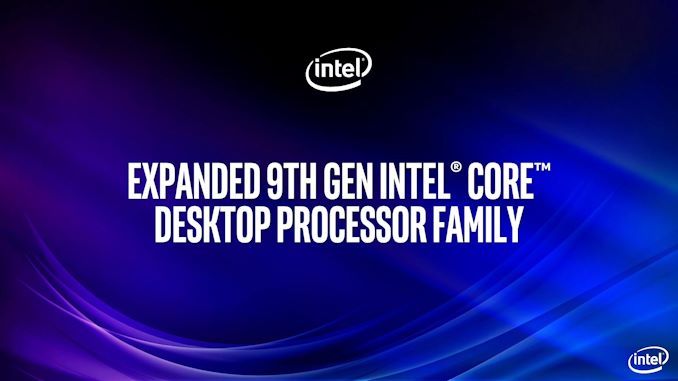
How Intel has launched its range of ninth generation processors has been an odd and awkward one. Despite the launch of the 8-core 9900K last year, we still haven’t had all of the lower end processors in the family actually be announced, despite several leaks in the meantime. That all changes today as the company is giving out a full list of processors, with availability soon to follow. There are still question marks about Intel’s ability to meet the new increased demand, so it will be interesting to see if Intel can still provide the lower frequency and lower core count hardware in volume.
Today’s launch comes in two parts: Desktop and Mobile. Desktop is on this page, Mobile is on the next page.
Intel 9th Generation Core Desktop Processors: 34 CPUs
Dubbed ‘Coffee Lake Refresh’, the 9th generation of Intel’s Core CPU product line is a direct refresh of its 8th generation Coffee Lake hardware, with minor enhancements such as a better thermal interface on the high end processors, support for up to 8 cores, and newer chipsets with integrated USB 3.1 Gen2 (10Gbps) and CNVi-enabled Wi-Fi. The hardware is still fundamentally the original 6th Gen Skylake microarchitecture underneath, from 2016, but built on Intel’s latest 14nm process variant, in order to extract additional frequency and efficiency, and with more cores at the high-end.
Intel sub-divides its CPUs in two ways. First, by the Core i-series number:
- Core i9: Eight cores, 9900 with HT, 9700 without HT
- Core i7: Eight cores, no HT
- Core i5: Six Cores, no HT
- Core i3: Four Cores, no HT
- Pentium Gold: Two Cores, HT
- Celeron: Two Cores, no HT
Then, each processor may have an additional suffix related to certain features that are enabled or disabled:
- K = Overclockable
- KF = Overclockable with No Integrated Graphics
- No Suffix = Standard CPU, 54-65W TDP, Integrated Graphics
- F = No Integrated Graphics
- T = Low Power, 35W TDP
The idea here is that the name of the processor should tell you all that you need to know about what the processor has available. Aside from the odd difference in the Core i9 section, it’s mostly all there.
New for the 9th generation CPUs is the F suffix, meaning no integrated graphics. We’ve commented on these parts before, but ultimately it would appear that Intel’s manufacturing ability to yield cores is better than its ability to yield graphics at the correct frequencies, so in order to maximize $ per square millimeter, it is now offering graphics-free versions of its popular CPUs. These parts are priced the same with or without graphics, which just goes to show you how much Intel values its current graphics implementation. As always, it will be interesting to see how much Intel can yield between F versions and regular processors.
Regarding normal processors and the lower power 35W TDP ‘T’ processors, the main variation here is in the base frequency. It should be noted that Intel’s TDP ratings are only valid at the base frequency of the processor, so even if the CPU has a high turbo, its peak power consumption during turbo may be a lot higher than the TDP value (Intel defines a Power Limit 2 value which is often 25% higher, but motherboard manufacturers usually ignore this). This is an attribute given solely by Intel CPUs, exacerbated by the motherboard manufacturers going beyond specifications, and we’ve detailed the issue in previous articles. Click the follow link to find out more:
https://www.anandtech.com/show/13544/why-intel-processors-draw-more-power-than-expected-tdp-turbo
Each CPU has a qualified memory support of DDR4-2666 for Core i5 and above, or DDR4-2400 for Core i3 and below. This means that while processors may support higher, Intel does not make any assurances as to whether it will work. All the processors are aligned with Intel’s Optane H10 storage solution, which was announced yesterday. Support with H10 is almost arbitrary, as H10 has to work with other CPUs as well.
We’re going to go through each of the sub-divisions, hopefully making the naming and numbering clearer.
| Intel 9th Generation Core CPUs Core i9 |
|||||||||
| AnandTech | Cores Threads |
Base Freq |
Turbo Freq |
L3 Cache |
DDR4 | IGP | TDP | Price (1ku) |
|
| i9-9900 | K | 8C / 16T | 3.6 GHz | 5.0 GHz | 16 MB | 2666 | Y | 95 W | $488 |
| i9-9900 | KF | 8C / 16T | 3.6 GHz | 5.0 GHz | 16 MB | 2666 | 95 W | $488 | |
| i9-9900 | 8C / 16T | 3.1 GHz | 4.9 / 5.0* | 16 MB | 2666 | Y | 65 W | $439 | |
| i9-9900 | T | 8C / 16T | 2.1 GHz | 4.4 GHz | 16 MB | 2666 | Y | 35 W | $439 |
| i9-9700 | K | 8C / 8T | 3.6 GHz | 4.9 GHz | 12 MB | 2666 | Y | 95 W | $374 |
| i9-9700 | KF | 8C / 8T | 3.6 GHz | 4.9 GHz | 12 MB | 2666 | 95 W | $374 | |
| * i9-9900 supports Intel Thermal Velocity Boost for +100 MHz Turbo | |||||||||
There are two main numbers in the Core i9 section, the 9900 family with HyperThreading, and the 9700 family without. Both the i9-9900K and i9-9700K have corresponding F versions without integrated graphics, as well as 35W ‘T’ versions which have much lower base frequencies.
Interestingly, Intel’s official documentation lists the Core i9-9900 as a 4.9 GHz processor, or 5.0 GHz when ‘Intel Thermal Velocity Boost’ is enabled and valid. If you’re wondering what Intel Thermal Velocity Boost is, so were we – Intel has never specifically mentioned it in any previous meeting or briefing, and it suddenly appears in a processor list slide. The slide actually lists the turbo as 5.0 GHz*, with the asterisk leading to a footnote which clarifies that it is 5.0 GHz when ITVB is enabled. It’s very sneaky how they’ve done that, and easy to miss if you are just skimming the spec sheet. Also doubling down on the awkwardness, the Core i9-9900 is the only processor in the whole stack that has this feature. Why just this one? I can guess the PR answer, but the real answer? Is Intel just trialling a feature? How is this feature going to be interpreted by the motherboard manufacturers? Are they going to butcher this one as well? Intel just opened a can of very specific worms that it pulled from a box it didn’t tell us about.
| Intel 9th Generation Core CPUs Core i7 |
|||||||||
| AnandTech | Cores Threads |
Base Freq |
Turbo Freq |
L3 Cache |
DDR4 | IGP | TDP | Price (1ku) |
|
| i7-9700 | 8C / 8T | 3.0 GHz | 4.7 GHz | 12 MB | 2666 | Y | 65 W | $323 | |
| i7-9700 | F | 8C / 8T | 3.0 GHz | 4.7 GHz | 12 MB | 2666 | 65 W | $323 | |
| i7-9700 | T | 8C / 8T | 2.0 GHz | 4.3 GHz | 12 MB | 2666 | Y | 35 W | $323 |
Moving onto the Core i7 parts, and we immediately have a problem. Here Intel has listed three Core i7-9700 CPUs. But wait, didn’t we have i9-9700 parts with the Core i9 family? Yes, we did. Intel has decided (or rather, someone at Intel wants to confuse everyone) that the 9700K processors should be Core i9, while the non-K parts should be Core i7. The differences between the i9 and i7 versions are just frequency and TDP, while we still have 8 cores without HT, and I can fully understand the desire to have a distinct separation between the two, but this is ultimately a shot at both obfuscation and confusion for partners, OEMs, users, and followers of Intel’s product line. Perhaps to make matters even worse, we have Core i9-K. We don’t have Core i7-K. We have Core i5-K, and Core i3-K. It makes me wonder if this naming and segmentation strategy is ever passed through a focus group beyond subsets of engineers or marketing.
| Intel 9th Generation Core CPUs Core i5 |
|||||||||
| AnandTech | Cores Threads |
Base Freq |
Turbo Freq |
L3 Cache |
DDR4 | IGP | TDP | Price (1ku) |
|
| i5-9600 | K | 6C / 6T | 3.7 GHz | 4.6 GHz | 9 MB | 2666 | Y | 65 W | $262 |
| i5-9600 | KF | 6C / 6T | 3.7 GHz | 4.6 GHz | 9 MB | 2666 | 65 W | $262 | |
| i5-9600 | 6C / 6T | 3.1 GHz | 4.6 GHz | 9 MB | 2666 | Y | 65 W | $213 | |
| i5-9600 | T | 6C / 6T | 2.3 GHz | 3.9 GHz | 9 MB | 2666 | Y | 35 W | $213 |
| i5-9500 | 6C / 6T | 3.0 GHz | 4.4 GHz | 9 MB | 2666 | Y | 65 W | $192 | |
| i5-9500 | F | 6C / 6T | 3.0 GHz | 4.4 GHz | 9 MB | 2666 | 65 W | $192 | |
| i5-9500 | T | 6C / 6T | 2.2 GHz | 3.7 GHz | 9 MB | 2666 | Y | 35 W | $192 |
| i5-9400 | 6C / 6T | 2.9 GHz | 4.1 GHz | 9 MB | 2666 | Y | 65 W | $182 | |
| i5-9400 | F | 6C / 6T | 2.9 GHz | 4.1 GHz | 9 MB | 2666 | 65 W | $182 | |
| i5-9400 | T | 6C / 6T | 1.8 GHz | 3.4 GHz | 9 MB | 2666 | Y | 35 W | $182 |
The Core i5 range is relatively traditional, featuring the 9600, 9500, and 9400 parts with some variants. The 9600 gets a K, a KF, and a T, whereas the 9500/9400 gets an F and a T only. Interestingly, the K parts here are the only overclockable members on the stack that have a TDP of 65W, compared to 91W or 95W. These parts offer increased base frequency (3.7 GHz vs 3.1 GHz), although have a tray pricing (1k unit purchase) of $49 higher than the non-overclockable parts.
| Intel 9th Generation Core CPUs Core i3 |
|||||||||
| AnandTech | Cores Threads |
Base Freq |
Turbo Freq |
L3 Cache |
DDR4 | IGP | TDP | Price (1ku) |
|
| i3-9350 | KF | 4C / 4T | 4.0 GHz | 4.6 GHz | 8 MB | 2400 | 91 W | $173 | |
| i3-9320 | 4C / 4T | 3.7 GHz | 4.4 GHz | 8 MB | 2400 | Y | 62 W | $154 | |
| i3-9300 | 4C / 4T | 3.7 GHz | 4.3 GHz | 8 MB | 2400 | Y | 62 W | $143 | |
| i3-9300 | T | 4C / 4T | 3.2 GHz | 3.8 GHz | 8 MB | 2400 | Y | 35 W | $143 |
| i3-9100 | 4C / 4T | 3.6 GHz | 4.2 GHz | 6 MB | 2400 | Y | 65 W | $122 | |
| i3-9100 | F | 4C / 4T | 3.6 GHz | 4.2 GHz | 6 MB | 2400 | 65 W | $122 | |
| i3-9100 | T | 4C / 4T | 3.1 GHz | 3.7 GHz | 6 MB | 2400 | Y | 35 W | $122 |
The Core i3 also follows its traditional scheme, with the 9350, 9320, 9300, and 9100 parts, the latter having slightly lower L3 cache per core and are priced accordingly. The 9350 is available as a K or a KF, but no standard SKU: instead, users can have the 9320. Only the 9300 and 9100 get low power T versions, and pricing within the Core i3 line is stable compared to the previous generation. It should be noted that the Core i3 parts (and below) only have qualified support up to DDR4-2400, rather than DDR4-2666 supported by the Core i5/i7/i9 processors.
I should point out that Intel is still not offering a quad-core for under $100 to compete with AMD’s Ryzen 3 2200G. The APU from AMD has four full Zen cores along with Vega graphics, dismantling any graphics workload compared to Intel’s offering, and it comes bundled with a good 65W cooler, whereas it’s a question mark sometimes if Intel’s CPUs come with a cooler (in order to meet tray pricing, probably not). Intel’s cheapest quad-core is the i3-9100, which is likely to offer better single threaded performance, but would be 30% more expensive at retail. If you can find one, that is – there are 2200G parts available almost everywhere.
| Intel 9th Generation Core CPUs Pentium Gold and Celeron |
|||||||||
| AnandTech | Cores Threads |
Base Freq |
Turbo Freq |
L3 Cache |
DDR4 | IGP | TDP | Price (1ku) |
|
| G5620 | 2C / 4T | 4.0 GHz | - | 4 MB | 2400 | Y | 54 W | $86 | |
| G5600 | T | 2C / 4T | 3.3 GHz | - | 4 MB | 2400 | Y | 35 W | $75 |
| G5420 | 2C / 4T | 3.8 GHz | - | 4 MB | 2400 | Y | 54W 58W |
$64 | |
| G5420 | T | 2C / 4T | 3.2 GHz | - | 4 MB | 2400 | Y | 35 W | $64 |
| G4950 | 2C / 2T | 3.3 GHz | - | 2 MB | 2400 | Y | 54 W | $52 | |
| G4930 | 2C / 2T | 3.2 GHz | - | 2 MB | 2400 | Y | 54 W | $42 | |
| G4930 | T | 2C / 2T | 3.0 GHz | - | 2 MB | 2400 | Y | 35 W | $42 |
| * G5420 can be derived from dual die (54W) or quad die (58W), see below | |||||||||
The Pentium Gold/Celeron parts bring up the cheaper end of the spectrum, from $42 up to $86. They are all dual cores, with the Pentium Gold CPUs supporting HyperThreading. The Celeron parts also have the smallest amount of L3 cache per core, with only 1 MB. The odd CPU from the bunch is the Pentium Gold G5420, which comes in 54W and 58W variants. Intel has done this before: one version of this CPU is derived from a dual core die (54W), while the other is a cut down quad-core variant (58W). In the past these two different models have had different part numbers, so users might be able to track which one they get. If there isn’t a part number listed on the retailer, then it’s a pot luck based on Intel’s binning and what they have in stock.
For these processors, users will have to pair them with a 300-series chipset. There is no new 300-series chipset launch today, so users can rely on the Z390/Z370/Q370/B360/H350/H310 models already in the market. Depending on the model chosen, they will have a number of PCIe lanes available, a number of SATA ports, a number of USB ports, and potentially some integrated Wi-Fi as well. It is up to the board manufacturers to support these features, or use corresponding controllers. It should be noted that with a firmware upgrade for the newest processors, most motherboards should start supporting Samsung’s new 32 GB memory modules, allowing for a total 128 GB of memory support on these CPUs (two DIMMs per channel, two channels).
Intel hasn’t reached out to us about reviewing any of these new processors, so if you have any thoughts of what parts you want to see tested, please let us know.
Over the page is our coverage of Intel's new Mobile processors, up to 5.0 GHz*.
The 45W range of processors from Intel fits into the high-performance / prosumer niche of portable gaming laptops and workstations. These typically populate the 15.6-inch and 17.3-inch devices, going from a basic gaming system with a discrete graphics card all the way up to DTR, or DeskTop Replacement hardware, that takes the place of a full on desktop in a (insert non-committal gesture) mobile sort of form factor that weighs almost double digits in pounds.
Intel has recently released some mobile processors into the market, such as Whiskey Lake at 15W on 8th Gen, but this is the first proper outing for high performance 9th Gen in a mobile form factor. At this point, we’re not seeing a replacement for Kaby Lake-G, where Intel paired a H-series CPU with a Radeon GPU in the same package, so it will be interesting to see if that gets a refresh later this year.
| Intel 9th Generation Core CPUs Mobile 45W H-Series |
||||||||
| AnandTech | Cores Threads |
Base Freq |
Turbo Freq |
L3 Cache |
DDR4 | OC | TDP | |
| i9-9980 | HK | 8C / 16T | 2.4 GHz | 4.9 GHz* | 16 MB | 2666 | Y | 45 W |
| i9-9980 | H | 8C / 16T | 2.3 GHz | 4.7 GHz* | 16 MB | 2666 | 45 W | |
| i7-9850 | H | 6C / 12T | 2.6 GHz | 4.6 GHz | 12 MB | 2666 | ish | 45 W |
| i7-9750 | H | 6C / 12T | 2.6 GHz | 4.5 GHz | 12 MB | 2666 | 45 W | |
| i5-9400 | H | 4C / 8T | 2.5 GHz | 4.3 GHz | 8 MB | 2666 | 45 W | |
| i5-9300 | H | 4C / 8T | 2.4 GHz | 4.1 GHz | 8 MB | 2666 | 45 W | |
| * i9 CPUs support Intel Thermal Velocity Boost for +100 MHz Turbo | ||||||||
Enter the Musclebook: Intel is introducing the new ‘Musclebook’ name for the DTR equivalent devices. Ultimately these are likely to be paired with the high end Core i9 processors. Intel has two parts here, the 9980HK which allows for overclocking, and the 9980H. The 9980H equivalent is new to this processor stack, based on requests from Intel’s partners that they wanted something ‘as fast’ as the top HK model, but not actually overclockable – it turns out that if you stick a HK in a system, users expect to be able to push it, and OEMs wanted equivalent performance without having to build in support for overclocking.
Both the 9980HK and 9980H supports Intel’s Thermal Velocity Boost, giving an additional 100 MHz if the thermal performance of the hardware allows it. Again, Intel doesn’t specify what requirements those are, of if manufacturers can ignore them, or if it’s enabled by default etc. It could be somewhat misleading to include those values into the single core turbo frequencies, however with mobile platforms we’ve seen such a wide range in PL2 values set in hardware due to the form factor, there are a wide range of single core turbo frequencies that don’t match up to the SKU list anyway – this is OEM and design dependent, so there isn’t much fuss from us on this.
There are two Core i7 parts, with six cores and hyperthreading, and the Core i7-9750H supports ‘Partial Overclocking’. In Intel terminology, this means that the CPU can be up to 400 MHz higher if the OEM sets it as such, allowing the CPU to turbo up to 5.0 GHz. That will be extremely device dependent, and given the way that most OEMs deliver their specification sheets, it will be interesting to see if any of them actually list if this is the case, or just take the 4.6 GHz and not tell anyone.
The two Core i3 parts bring up the rear, with four cores and hyperthreading. This means Intel still makes quad cores with hyperthreading, even though they have disappeared from the desktop product line.
Given the tight integration of mobile chipsets into the products, expect to see a few new devices enabled with Intel’s new AX200 Wi-Fi 6 card that was launched last week. The mobile chipsets are also listed as supporting Samsung’s new 32 GB memory modules, so we will likely see some high-end ‘Musclebooks’/DTR replacements using those, at extreme cost to the user. Intel is again stating Optane storage support on these devices, as well as TB3 support when additional controllers are included.
With the annual Computex trade show around the corner (last week of May), we’re expecting to see a smorgasbord of devices being offered with the new H-series parts: both refreshes of old models and perhaps some new ones in the mix. Stay tuned for our coverage from the show.
https://www.anandtech.com/show/14256/intel-9th-gen-core-processors-all-the-desktop-and-mobile-45w-cpus-announced
2019-04-23 14:00:00Z
52780275427516
Bagikan Berita Ini

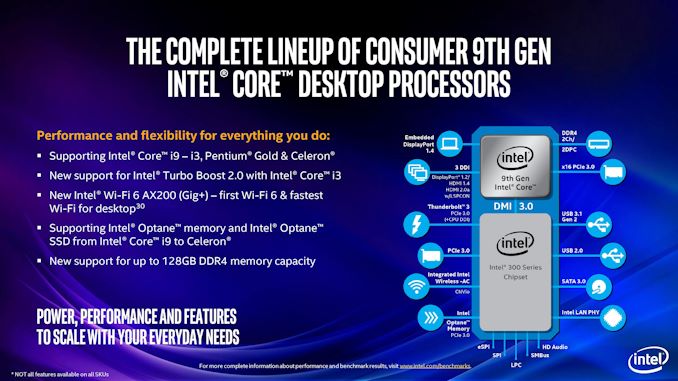
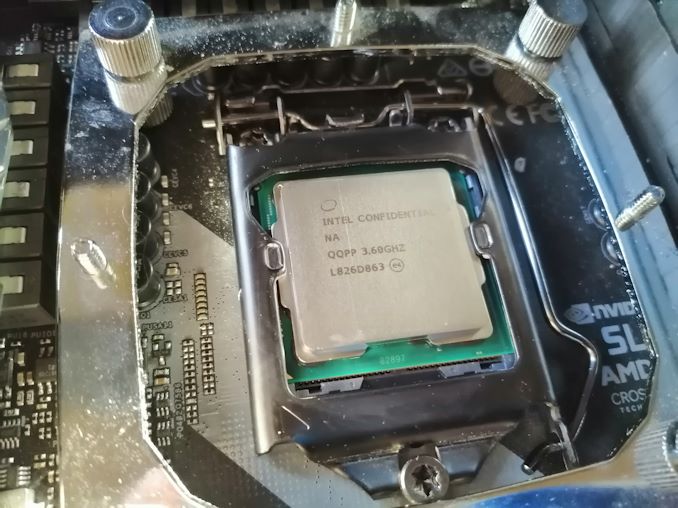
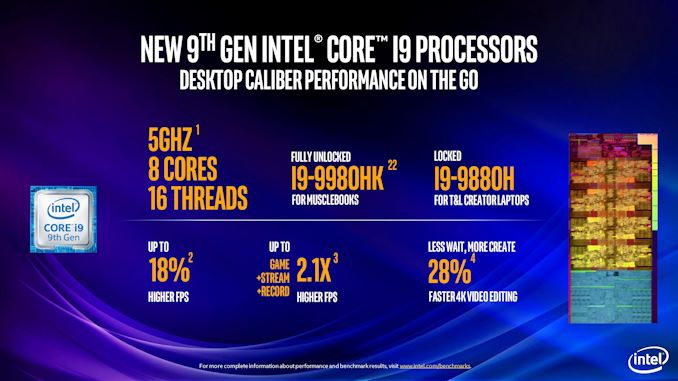

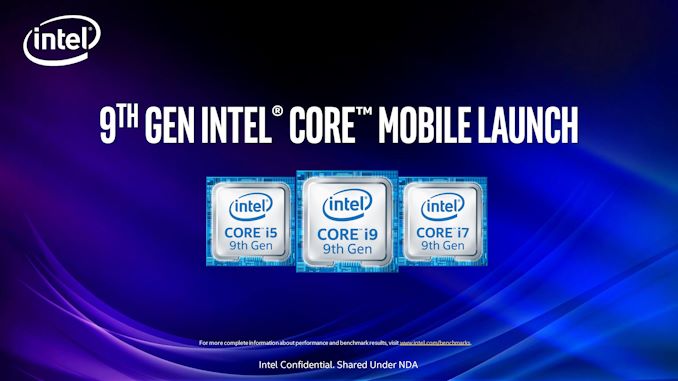

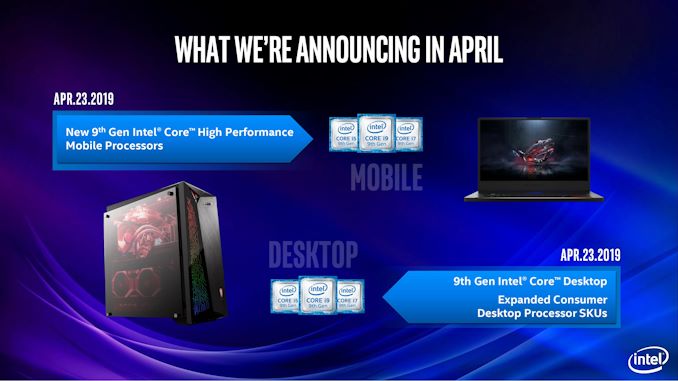
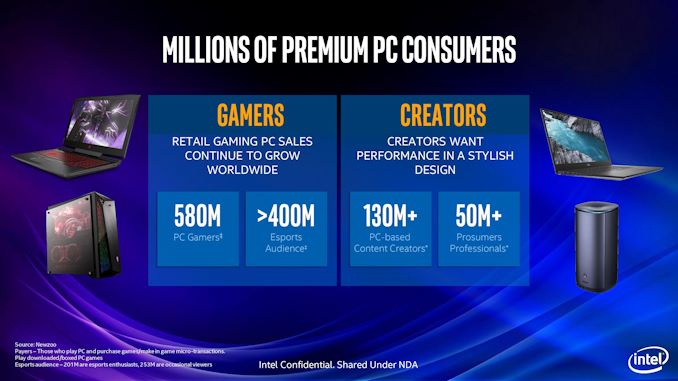
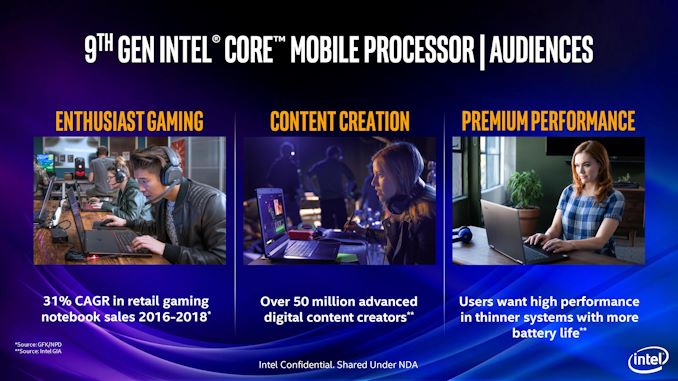

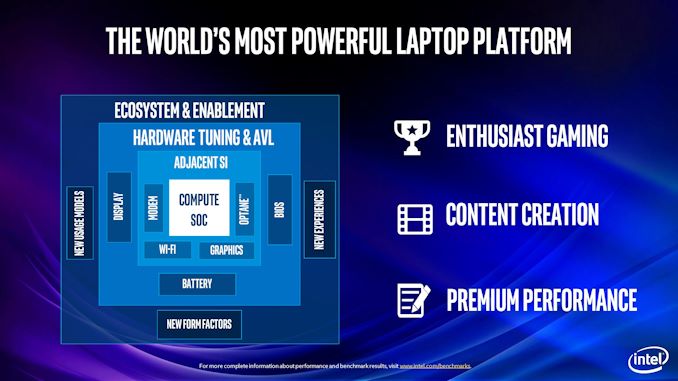
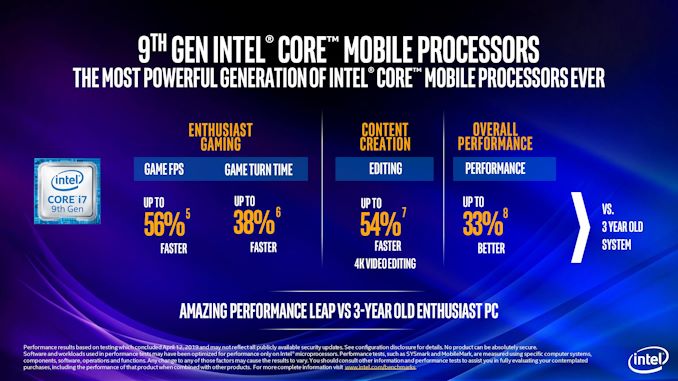
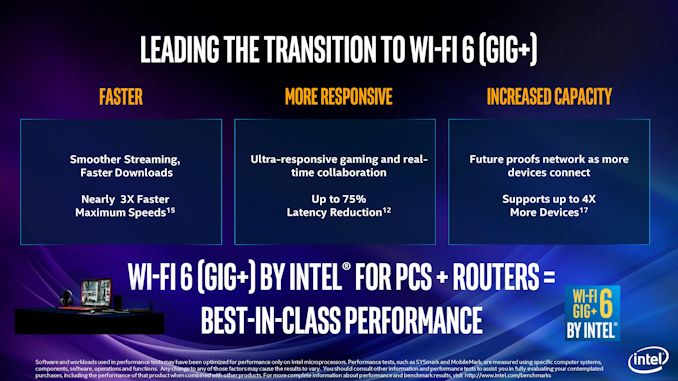


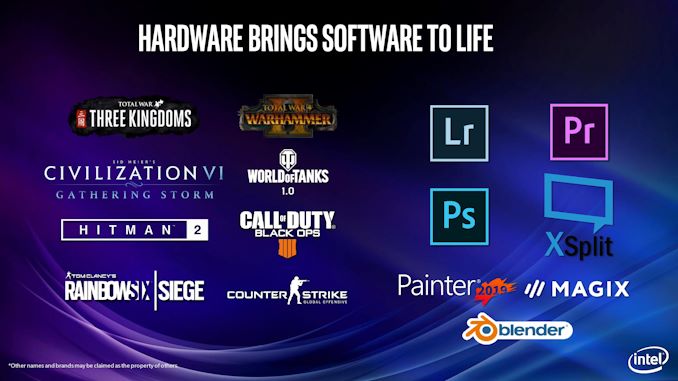
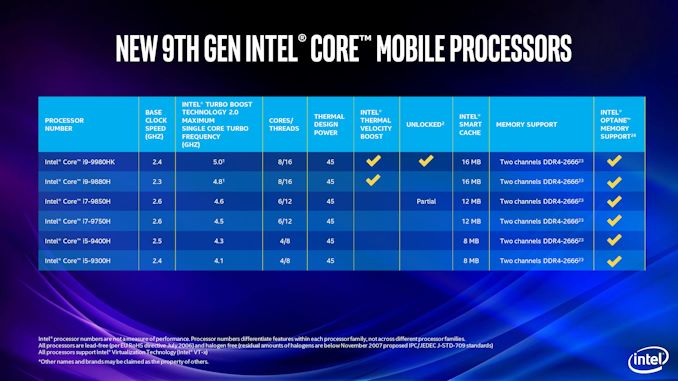
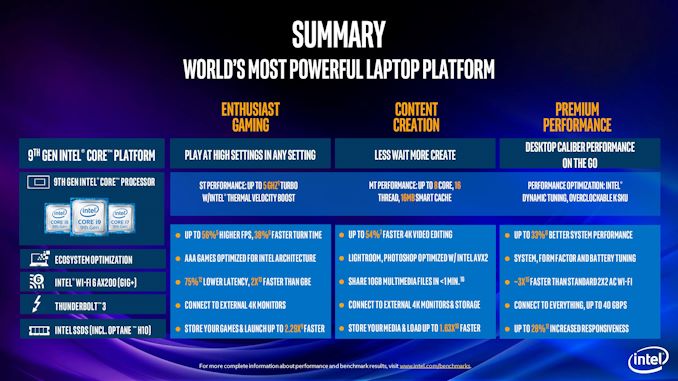
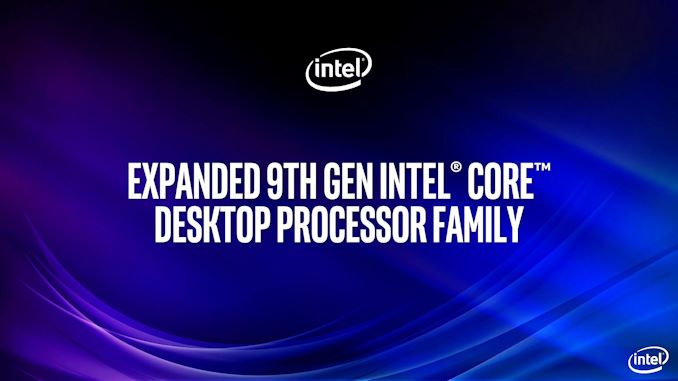
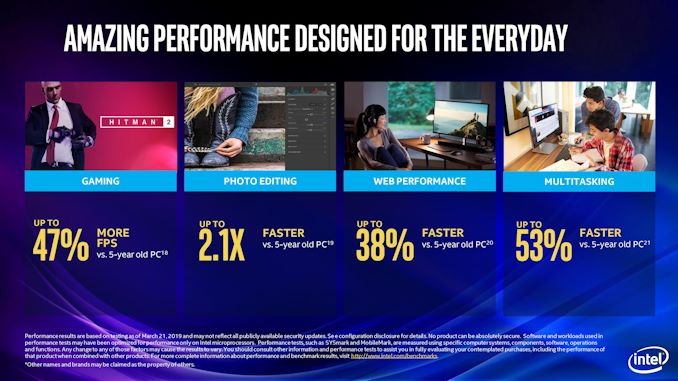
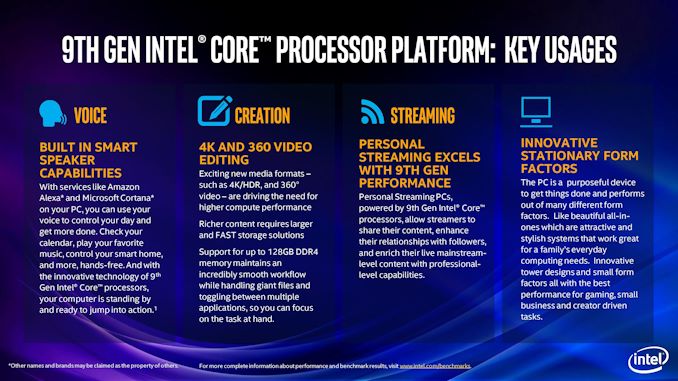
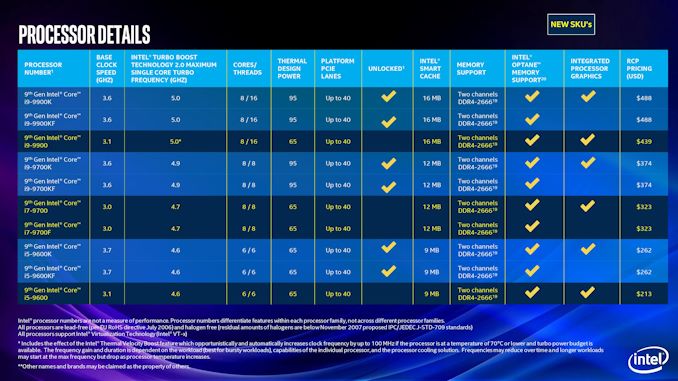
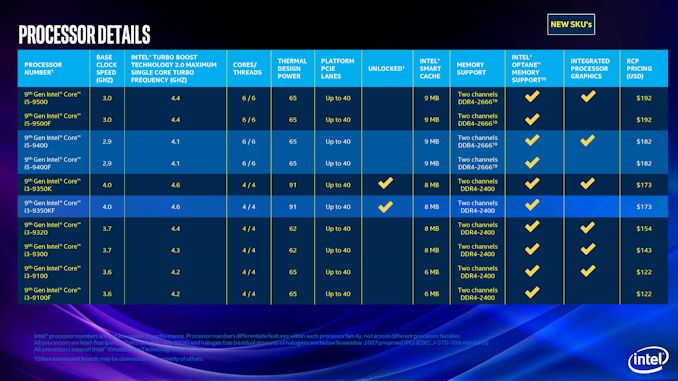
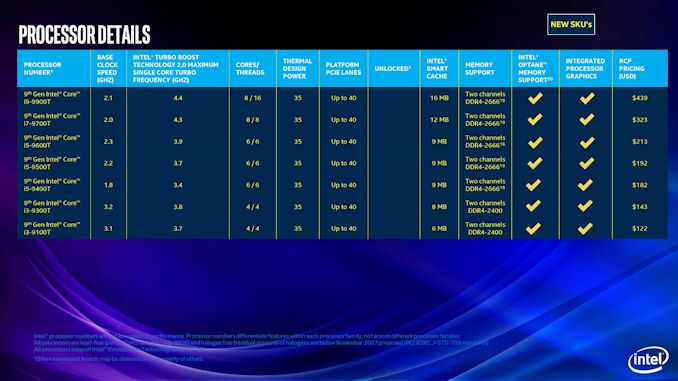

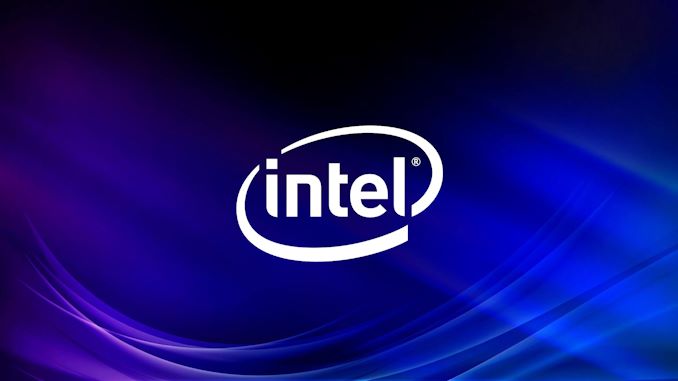
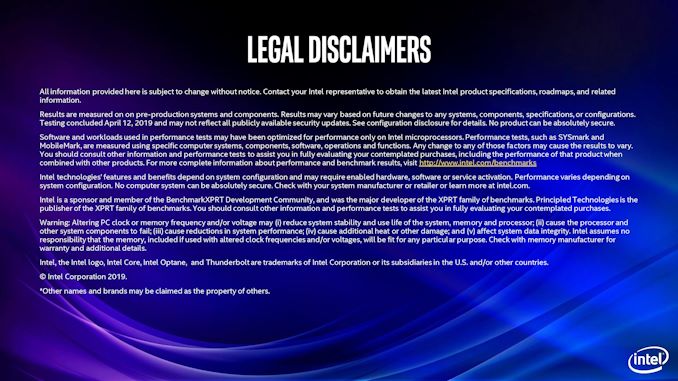


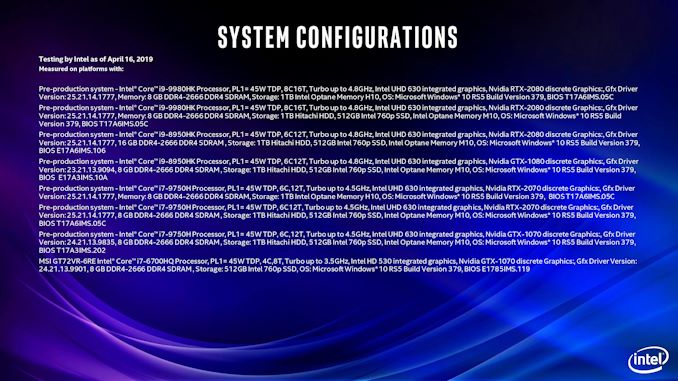
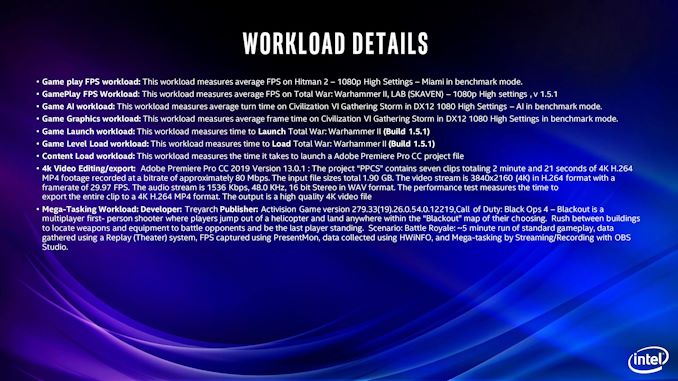
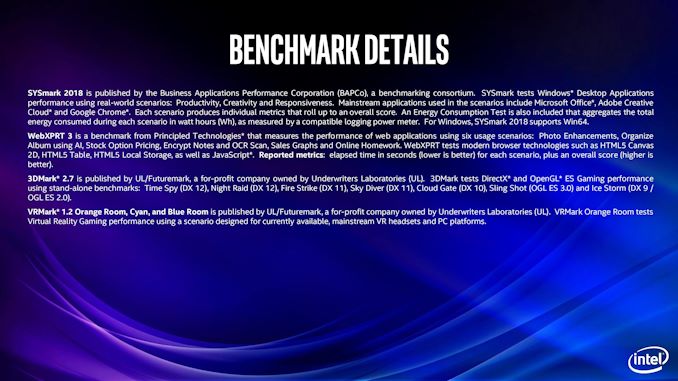














0 Response to "Intel 9th Gen Core Processors: All the Desktop and Mobile 45W CPUs Announced - AnandTech"
Post a Comment